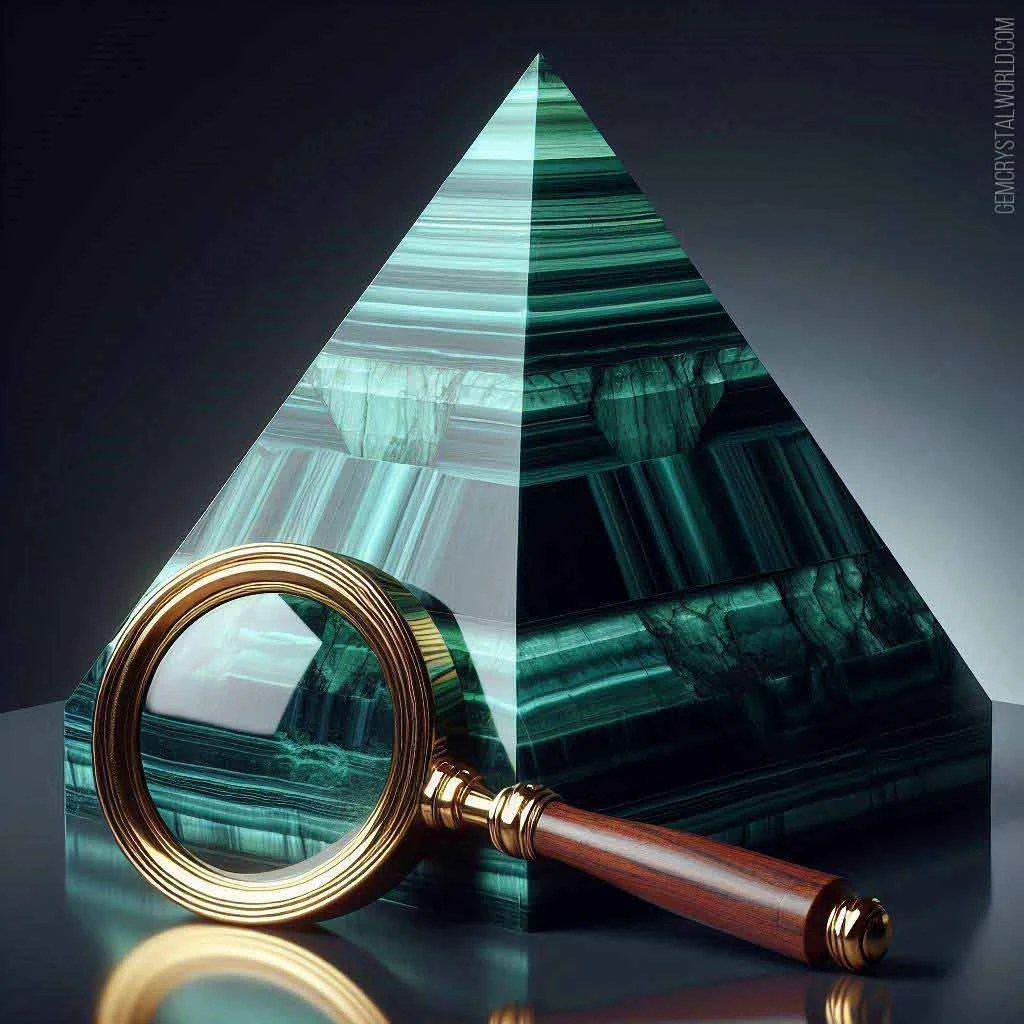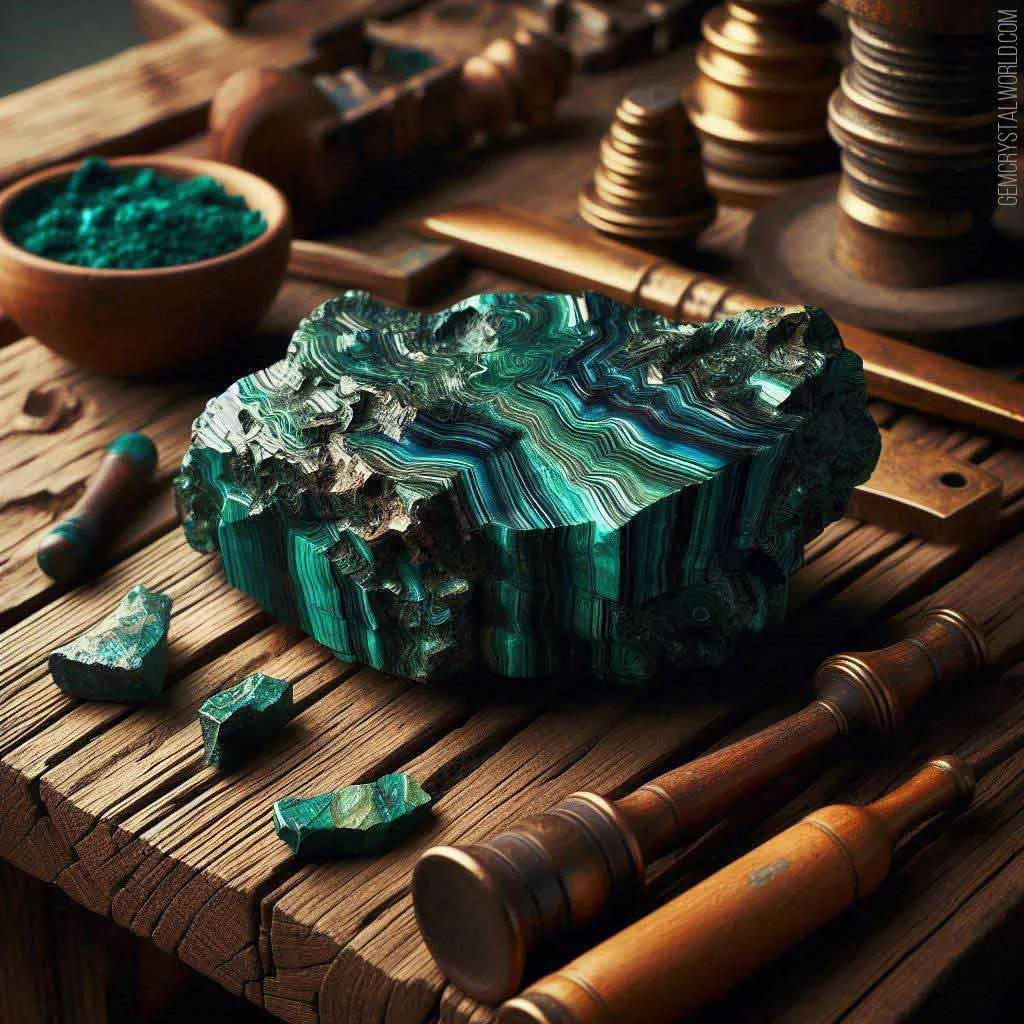Malachite Crystal: Complete Guide to Meaning, Properties, and Significance
Malachite Crystal: A Comprehensive Guide to Nature's Green Masterpiece
Introduction
Malachite, a stunning green mineral that has captivated humanity for thousands of years, is more than just a beautiful stone. This comprehensive guide will explore the fascinating world of malachite, delving into its origins, properties, uses, and cultural significance.
What is Malachite?
Malachite is a copper carbonate hydroxide mineral with a rich, vibrant green color that ranges from light emerald to deep forest green. Its name derives from the Greek word "malache," meaning "mallow," referencing the mineral's similar green hue to the leaves of the mallow plant.
Technical Characteristics
- Chemical Composition: Cu₂CO₃(OH)₂
- Color: Varying shades of green, from light to dark
- Hardness: 3.5-4 on the Mohs scale
- Crystal System: Monoclinic
- Luster: Silky to dull, sometimes with a vitreous surface
- Transparency: Opaque
Geological Origins and Formation
Malachite forms through a fascinating geological process involving the weathering of copper ore deposits. When copper-bearing minerals are exposed to carbon dioxide and water, they undergo chemical transformations that result in the creation of this stunning green mineral.
Natural Occurrence and Deposits
Malachite is primarily found in:
- Democratic Republic of Congo (world's largest producer)
- Russia
- Australia
- United States (Arizona)
- Mexico
- Zambia
- Chile
The mineral typically forms in oxidation zones of copper deposits, often found in association with azurite and other copper-based minerals.
 |
| The malachite pieces are displayed on a beige cloth, contrasting with the breathtaking natural landscape visible in the background |
Mining and Extraction
Mining malachite involves several sophisticated techniques:
- Open-pit mining
- Underground mining
- Chemical extraction methods
 |
| This image showcases a striking malachite ring, with the vibrant green mineral forming the centerpiece of the piece |
Production and Economic Value
According to recent geological surveys, annual malachite production is estimated at approximately 50,000-70,000 metric tons. Raw malachite prices range from $5 to $50 per kilogram, depending on quality and size.
Quote: "Malachite blocks in Mednorudyansk near Nizhny Tagil reached 250 tons (discovery in 1836); they had to be broken into pieces and extracted from the depths in separate chunks weighing 2 tons each. The famous Malachite Hall of the Winter Palace is adorned with malachite from this famous block" - Alexander Fersman (1928) Entertaining Mineralogy
Industrial and Artistic Applications
Jewelry and Decorative Arts
Malachite has been prized for centuries in:
- High-end jewelry design
- Decorative objects
- Architectural elements
- Sculptures
- Ornamental inlays
Notable examples include the malachite rooms in the Winter Palace in St. Petersburg, Russia, featuring stunning malachite columns and decorative panels.
Typical pricing for malachite products:
- Small jewelry pieces: $50-$500
- Large decorative objects: $1,000-$50,000
- Museum-quality antique items: Can exceed $100,000
Industrial Uses
- Copper production
- Pigment manufacturing
- Ceramic glazes
- Scientific research
Cultural and Metaphysical Significance
Mythological and Healing Properties
Different cultures have attributed various meanings to malachite:
- Ancient Egyptians used it as a protective stone
- Native American Traditions of Transformation
Native American Perspectives on Malachite
In Native American spiritual traditions, malachite is revered as a profound stone of personal transformation and inner growth. Many tribes viewed the stone's distinctive green patterns – which resemble layers and intricate pathways – as a metaphorical representation of life's complex journey.
The stone was often used in ceremonial practices and healing rituals, symbolizing:
- Personal metamorphosis
- Overcoming life's challenges
- Spiritual evolution
- Connection with the natural world
- Inner healing and emotional release
Tribal shamans and medicine people would use malachite in meditation and healing practices, believing its energy could:
- Help individuals navigate significant life transitions
- Release deep-seated emotional blockages
- Encourage personal courage and self-reflection
- Facilitate communication with spiritual realms
- Promote understanding of one's true path
The stone's green color, reminiscent of growth, renewal, and the natural world, further reinforced its significance as a transformative tool in Native American spiritual practices.
Modern crystal healing practices associate it with:
- Emotional healing
- Protection
- Personal growth
- Energy cleansing
Zodiac and Astrological Connections
- Associated with Taurus and Scorpio zodiac signs
- Believed to enhance intuition and personal power
Safety and Handling
Toxicity Considerations
Important Safety Note: Malachite contains copper and can be toxic if:
- Inhaled as dust
- Ingested
- Processed without proper protective equipment
Recommended handling:
- Wear protective masks during cutting/grinding
- Wash hands after handling
- Avoid creating fine dust
- Do not use for drinking water or food preparation
Environmental and Sustainability Aspects
The mining of malachite, like many mineral extractions, raises environmental concerns. Responsible mining practices focus on:
- Minimizing ecological disruption
- Implementing rehabilitation programs
- Reducing chemical processing impacts
Malachite: Frequently Asked Questions
- Worldwide locations: Democratic Republic of Congo, Zambia, Russia, Australia, and various other countries
- USA locations: Arizona, New Mexico, and Utah
- Australian deposits: Queensland and New South Wales
- Often found alongside azurite due to similar formation conditions
- High-quality malachite is relatively rare, especially large pieces with attractive patterns
- Price varies significantly based on quality, pattern, and size
- Generally less expensive than high-quality jade, particularly fine jadeite
- While top-grade malachite can command high prices, premium jade (especially Imperial jadeite) is typically more valuable and expensive
- The value of both stones depends heavily on quality, with jade having a wider price range due to its various types (jadeite vs nephrite) and grades
- Value is determined by color intensity, pattern quality, and size
- Raw malachite contains copper and can be toxic if ingested or if dust is inhaled during cutting/polishing
- Finished, polished malachite jewelry is safe to wear
- Proper safety measures should be taken when working with raw malachite
- Not carcinogenic, but dust can cause respiratory issues if inhaled
- Should not be submerged in water
- Avoid exposure to water, salt, and sunlight
- Brief contact with water (like washing hands) is generally okay for polished pieces
- Cannot be cleansed in water or salt
- Clean gently with a soft, dry cloth
- Avoid chemicals, ultrasonic cleaners, and harsh cleaning methods
- Store separately to prevent scratching
- Keep away from direct sunlight to prevent fading
- Associated with the Heart Chakra
- Connected to the element of Earth
- Often associated with the planet Venus
- Jewelry (rings, bracelets, necklaces)
- Decorative objects and carvings
- Meditation focus
- Crystal healing practices
- Where to wear: Often worn on the left wrist or as pendants near the heart
- Placement: Many practitioners place it in living spaces or meditation areas
- Traditionally symbolizes transformation and change
- Associated with protection and healing in various cultures
- Represents growth, abundance, and manifestation
- Often connected to nature and earthly energies
- Malachite is exclusively green in various shades
- Cannot be naturally blue or purple
- Color variations range from light to dark green
- Often displays distinctive banded or swirled patterns
- Breaking: Can release potentially harmful dust
- Heating: Can change structure and color
- Polishing: Brings out the characteristic patterns and luster
- Can be tumbled with proper precautions
- Both are minerals but with different compositions
- Malachite is copper-based, while pyrite is iron-based
- They can occur together in some deposits
- Different crystal systems and physical properties
Conclusion
Malachite is far more than a simple green stone. It represents a complex intersection of geological marvel, artistic inspiration, and cultural significance. From its formation deep within the Earth to its beautiful applications in art and industry, malachite continues to fascinate and inspire.
We appreciate any references or links back to our site when using our resources!









